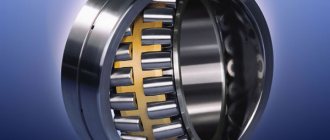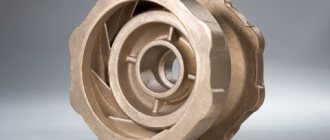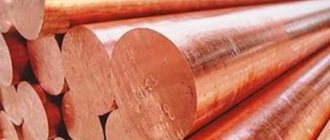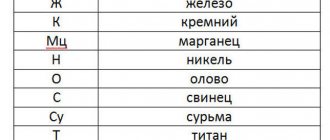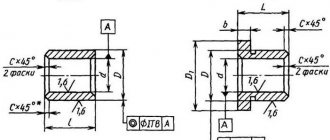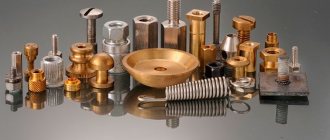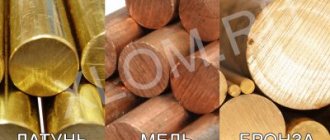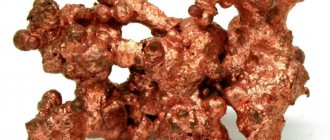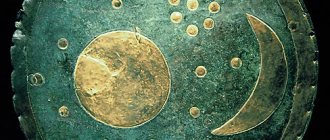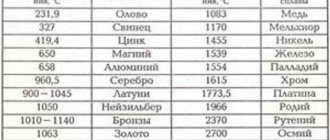0
Plain bearing materials
There are ductile (< HB 50), soft (HB 50-100) and hard (> HB 100) bearing alloys.
Plastic materials include babbitts, lead bronzes, aluminum alloys, and silver; for soft bronzes - tin, tin-lead, tin-lead-zinc; to hard ones - bronze, aluminum-iron and cast iron.
For highly loaded high-speed bearings designed to operate in the field of liquid lubrication, plastic alloys are used almost exclusively in the form of thin layers applied to steel (less often bronze) bushings and liners.
Soft and hard alloys are used for the manufacture of boundary and semi-fluid lubricated bearings operating at moderate speeds.
Why are rolling bearings needed?
Fixes position in space, provides rotation, rolling
with the least resistance, absorbs and transmits the load from the moving unit to other parts of the structure.
A support with a thrust bearing
is called a thrust bearing.
Interesting materials:
How long are records stored in hypermarkets? How long are call recordings stored? How long do fried eggs last in the refrigerator? How long do fried mussels last? How long should the archive be kept? How long can porcini mushrooms be stored in the refrigerator? How long to store red wine? How long can I store chilled pork? How long can olive oil be stored unopened? How long should opened cheese be stored?
Babbitts
Babbitts are alloys of soft metals (Sn, Pb, Cd, Sb, Zn), characterized by the presence of hard structural components in a plastic matrix.
Babbitts are characterized by a low coefficient of friction, ductility, good run-in and wear resistance.
Plasticity ensures uniform distribution of the load over the bearing surface: it becomes relatively safe for small solid particles (metal dust, solid oil oxidation products) to enter the bearings, which are pressed into the babbitt and rendered harmless.
The disadvantage of babbitts is their low fatigue resistance, especially at elevated temperatures.
Babbitts can be paired with normalized or improved steel shafts (HRC 25-35), but to increase bearing durability it is more advisable to heat treat the shafts to a hardness > HRC 50.
High-tin babbitts, which are alloys of tin and antimony with small additions of copper (introduced to prevent segregation); Babbitt structure is solid SnSb crystallites embedded in plastic eutectic.
The main brands of high-tin babbitts are B89, B83 (the numbers indicate the tin content as a percentage).
Their thermal conductivity is (3.0–4.2)·10–2 W/(m·°C); coefficient of linear expansion (22-24)·106. Modulus of normal elasticity E = (5-6)·104 MPa. Density 7.3 kg/dm3. Hardness at 20°C HB 20-30; compressive yield strength 40-60 MPa. At 100-120°C, hardness and yield strength are reduced by approximately half.
Melting point of tin babbitts: beginning 240-250°C, end 400-420°C.
Babbitts are poured at 450-480°C onto liners preheated to 250°C. Centrifugal pouring gives the best results. Pouring into chill molds and under pressure is also used.
The thickness of the filling layer in bearings of conventional design is 1-3 mm. The fatigue resistance of Babbitt fill increases with decreasing thickness of the fill layer, as well as with increasing rigidity of the liner-bed system. Recently, the thickness of the fill has been increased to 0.25-0.4 mm. Even better results will be obtained by electrolytically depositing a layer of babbitt 10-20 microns thick on a porous bronze substrate.
A decrease in the strength of Babbitt fill at elevated temperatures is prevented by intensive oil cooling of the bearings. All this makes it possible to increase the specific loads on bearings with Babbitt filling to 10-15 MPa.
In order to save scarce tin, low-tin babbits have been developed and introduced into industry, which are more or less complete substitutes for high-tin babbits.
Lead-tin babbits B16, B6, BN, BT consist of 60-75% lead, 5-20% Sn, 10-20% Sb with small additives Cu, Cd, Ni, Fe. 0.3-1% As is introduced as modifiers.
The antifriction qualities of lead babbitts under semi-liquid lubrication conditions are lower than those of high-tin babbitts. Their thermal conductivity is (1.2–2.4)·10–2 W/(m·°С), density is 9.5–10 kg/dm3. The hardness and mechanical properties are approximately the same as those of tin babbitts. Corrosion resistance is significantly lower.
Under liquid lubrication conditions, the difference between lead and tin babbits is hardly noticeable.
Tin-free babbits BK1, BK2 consist almost entirely of lead with additives of ~1% Ca and Na. The antifriction properties and corrosion resistance of lead babbitts are improved by introducing Sr, Ba, Li, and Te in small quantities.
The composition and properties of tin and lead babbits are given in table. 28.
Cadmium babbits contain 90-97% Cd with additives of Cu, Ni, Ag and other metals that form solid structural components in the plastic cadmium base. The hardness of cadmium babbitts is HB 30–40, the coefficient of linear expansion of these babbits is ~30·10–6 1/°С, and the thermal conductivity is (8.4–10.0)·10–2 W/(m·°С).
Antifriction qualities are high. The disadvantage of cadmium babbitts is their low corrosion resistance.
Aluminum-tin alloys containing up to 20% Sn are used in bimetallic thin-walled liners. The most common alloys are the AO20-1 type (20% Sn; 1% Cu; the rest Al) and the AO6-1 alloy (6% Sn; 1% Cu; 0.5-1% Ni; 1-1.5% Si; the rest AI). The hardness of antifriction aluminum alloys is HB 35—45; thermal conductivity 0.18–0.24 W/(m °C); coefficient of linear expansion (20–22)·10–6 1/°С, density 2.7 kg/dm3.
Aluminum alloys have high fatigue resistance and can operate at specific loads up to 50 MPa. Prone to enveloping the shaft. Increased oil pumping and the use of shafts of increased hardness (> HRC 50) are required.
For non-critical bearings, cheap zinc-aluminum alloys such as TsAM 10-5 (10% Al; 5% Cu, the rest Zn) and TsAM 9-1.5 (9% Al; 1.5% Cu) are used. Their hardness is HB 60-80; linear expansion coefficient (30–32)·10–6; density 6.2 kg/dm3. The antifriction qualities of zinc-aluminum alloys are mediocre. It is necessary to use shafts with a hardness of more than HRC 50. Non-standard high-aluminum zinc alloys (30-40% Al; 5-10% Cu; the rest Zn) have the best qualities. Their hardness is HB 50-60.
Anti-friction cast irons
Antifriction cast irons are used as cheap substitutes for bronzes: gray AChK with flake graphite, high-strength AChK with globular graphite, malleable AChK with flake graphite and cuprous FM (Table 30).
The disadvantages of antifriction cast irons are fragility and high hardness (HB 160-250), which excludes the possibility of self-breaking in. Cast iron bearings are sensitive to misalignment, causing high edge pressures.
Cast iron bearings are used with shafts of high surface hardness (> HRC 55). Soft antifriction cast irons (AChS-3, AChV-2, AChK-2) can work in tandem with normalized or improved steels (HRС 25-35) under light loads.
Bronze
Bronze is used for the manufacture of bearings operating in the area of predominantly semi-liquid lubrication at low peripheral speeds (bearings for auxiliary drives). Due to their increased hardness, they can withstand high specific loads.
The most common are tin, tin-lead and tin-zinc-lead bronzes (Table 29).
Tin bronzes of the BrOF type have good antifriction properties. Bronzes with a content of >0.5% Sn are cast (preferably in chill molds), those with a content of <0.5% Sn are stamped. The hardness of stamped bronzes can be reduced to HB 50-60 through softening annealing.
The introduction of lead (BrOS bronze) improves machinability, increases ductility and reduces the hardness of bronze. Bronze BrO5S25 belongs to the category of semi-plastic.
The most widely used are tin-zinc-lead bronzes, in which the content of scarce tin is reduced to 2-6%. Their ductility is higher than that of tin bronzes (elongation 6-15%); hardness HB 50-70. Tin-zinc-lead bronze BrOTsS 4-4-2.5 is used in the form of cold-rolled strips for the manufacture of thin-walled bushings.
Aluminum-iron bronzes of the BrAZh type, which have increased hardness (HB 70-100), are used for the manufacture of bushings operating at high loads and low speeds under conditions of semi-fluid and boundary lubrication (guide bushings for suction valves of internal combustion engines).
Bearings operating at high temperatures with boundary lubrication (exhaust valve guides) are made of heat-resistant iron-nickel-aluminum alloys of the BrAZhN type.
Thermal conductivity of antifriction bronzes is 0.06–0.12 W/(m °C); coefficient of linear expansion (16—18)·10–6; elastic modulus E = (8–10)·104 MPa.
Shafts operating in medium-hard bronze bearings must have a hardness of more than HRC 50, and in high-hardness bronze bearings more than HRC 55.
Multilayer coatings
In multilayer casting, a thin layer of tin babbit is applied to a substrate made of an antifriction alloy with a thickness of 0.2–0.5 mm. By making use of the valuable properties of tin babbits, this method dramatically reduces tin consumption and at the same time increases the fatigue resistance and resistance of the casting to shock loads.
Lead bronzes, aluminum alloys and bronzes are used as substrates. The best results are obtained by porous substrates made of sintered Cu–Al and Cu–Ni alloys (60% Cu, 40% Ni), which ensure a strong bond between the babbitt and the liner.
There are two methods of applying babbitt. When pouring, babbitt is applied in a layer of 0.3-0.4 mm. After processing, the thickness of the babbitt layer is 0.15–0.2 mm.
A more technologically advanced method is the electrolytic deposition of babbitt with a layer 15–20 μm thick on the surface of a substrate that has been thoroughly processed. With this method, it is necessary to use a porous substrate, which, when impregnated with babbitt, forms an anti-friction sublayer that ensures proper operation of the bearing in case of local or general wear of the surface babbitt layer.
Sometimes lead babbits are used as a surface layer. To prevent corrosion, an electrolytic layer of In with a thickness of several micrometers is applied to them, which is then subjected to diffusion by heating at 150°C for 2-3 hours.
Silver
For heavily loaded bearings of machines produced in small series, bearings with a friction surface made of silver (added with small amounts of Sn and Pb) are used.
Silver coatings are distinguished by ductility, softness (in the annealed state, HB 25-35), good anti-friction properties and high fatigue resistance.
The thermal conductivity of silver coatings is high - 0.36-0.42 W/(m °C). Linear expansion coefficient 18·10–6. Elastic modulus E = 8.2·104 MPa. Melting point 960°C.
Silver is poured onto the surface of the liners in a layer of 0.1-0.3 mm or applied electrolytically onto a porous bronze or copper-nickel substrate in a layer 20-50 microns thick.
In some cases, to improve the connection with the liner, silver is poured onto a fine-mesh steel base. The sections of the steel matrix protruding to the surface increase the load-bearing capacity of the bearing.
In order to improve run-in, a layer of lead or lead-antimony spleen 10-30 microns thick is applied to the surface of the silver coating, which is covered with a layer of indium several micrometers thick to prevent corrosion.
It is necessary to use shafts of increased hardness (> HRC 50).
Lead bronzes
Lead bronzes are alloys of Cu (40-70%) and Pb (30-60%) with additives of small amounts of Sn, Zn, Ni, Ag. In the USSR, the most common bronzes are BrS30 (30% Pb; the rest is Cu) and BrO5C25 (5% Sn; 25% Pb; the rest is Cu). High-lead nickel bronze BrS60N2.5 (60% Pb; 2.5 Ni) is also used.
Lead is practically insoluble in copper and is present in alloys in the form of rounded inclusions, more or less evenly distributed in the copper matrix.
Lead bronzes are stronger and harder than babbitts (HB 40-60). Unlike babbitts, their hardness and strength remain almost constant up to 200°C. Thermal conductivity 0.12–0.13 W/(m °C).
The disadvantage of lead bronzes is their reduced corrosion resistance (due to the presence of free lead). In addition, lead causes accelerated oxidation of the oil during operation.
The run-in properties and antifriction properties of lead bronze are worse than those of Babbitts. Bearings filled with lead bronze require particularly low roughness of friction surfaces, elimination of distortions, increased rigidity of the shaft-bearing system, increased oil pumping and thorough filtration, as well as increased surface hardness of the shaft (>HRC 50). The clearances in bearings filled with lead bronze are on average 30-50% larger than in bearings filled with Babbitt. It is advisable to use oils with a low acid number (< 1 mg KOH/g) and add antioxidant additives to the oil.
The working surfaces of bearings filled with lead bronze are processed by fine boring with diamond or carbide cutters with low feeds and high cutting speeds (10-13 m/sec).
Lead bronze is poured onto liners made of low-carbon steel in a layer 0.5–0.8 mm thick at 1050°C in graphite molds. To avoid segregation and to obtain a uniform and finely dispersed distribution of lead in the alloy, immediately after pouring, the liners are subjected to intensive cooling with water sprayed with compressed air.
Improved compositions of lead bronzes with 30% Pb with additives of Ni (up to 5%), Sn (up to 25%) and small amounts of S and Ca have been developed. The Ni additive increases corrosion resistance, S and Ca are introduced to prevent lead segregation.
Along with high-lead bronzes, ductile (HB 60-80) bronzes containing 5-7% Pb, 5% P and 5% Zn are used for filling bearings.
Bronze bushing: why choose it
Bronze bushing
: why choose her
Bronze bushings are high-tech assembly consumables that are characterized by good ductility. The parts are used in equipment subject to significant mechanical stress and ensure the safety of the main parts of the structure. The intensity of the work process does not lead to loss of properties.
A cheap alternative is bushings made of polymers, but their scope of application remains narrow, and such products cannot withstand extreme loads at all.
Bronze parts do not crack. The main alloy is inert towards environments of any aggressiveness. Consequently, the scope of application of the part is wide.
By the way: the properties of bronze were valued by our ancestors. It is known that the Celts in the 8th century. BC e. bronze components of the harness were used. At that time, horse harness was one of the most loaded structures. Such luxury with inclusions of expensive metal was available only to the elite of that time.
